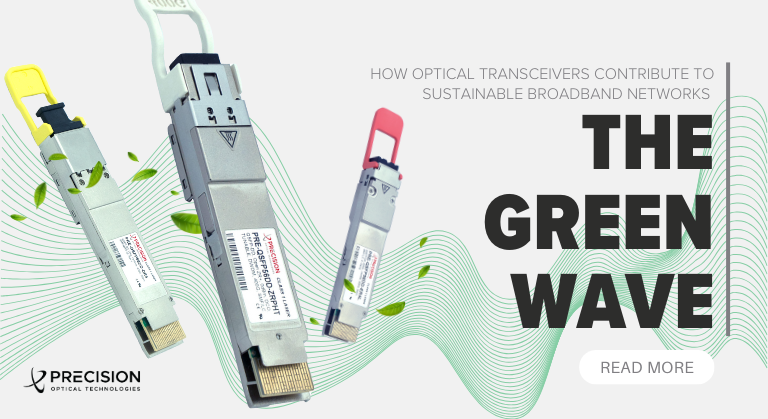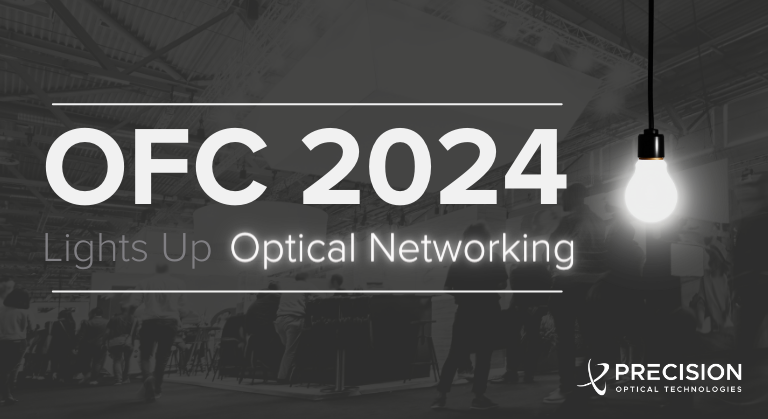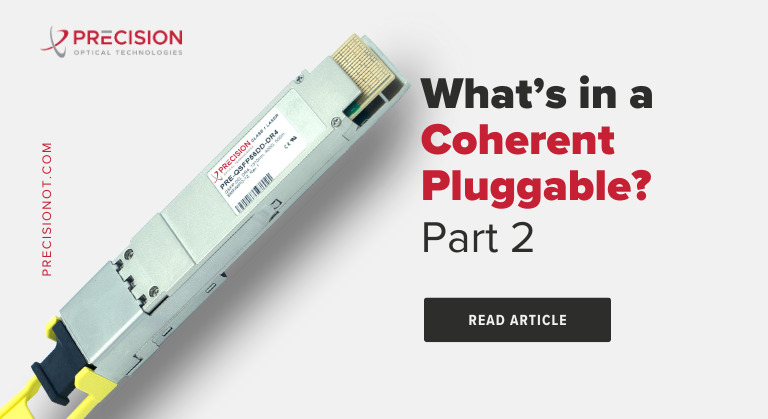
OFC 2024 Lights Up Optical Networking

Showcasing groundbreaking innovations and fostering collaboration, the premier event for optical networking and communication was held last week in San Diego, CA. OFC 2024 brought industry-leading companies & products to the show floor and held technical sessions covering Optical Fiber Transmission, Security, Coherent Technologies, Passive Optical Networks, Data Centers and the latest emerging technologies in AI, Quantum Networking, Cloud and Edge Computing, 6G and Satellite Networks.
6G, Quantum, and Z Highlighted in the OFC 2024 Plenary Session
In the Plenary session, presenter Anita Döhler of the Next Generation Mobile Networks (NGMN) Alliance examined how 6G will impact networking, previewing technology advancements and the importance of meeting prerequisites to enable innovative use cases which create value and exceptional end-user experiences. By examining various trade-offs, including energy consumption vs. bit rates, Döhler identified the critical role optical communications will play in enabling operator-led requirements such as disaggregation, resilience, and energy efficiency.
Inder Monga, in his presentation entitled “Networking Alchemy: Transforming Science Through Connectivity” explained that right now quantum networking is in the “dial-up modem stage” – we can’t even imagine all its possibilities. Energy Sciences Network (ESnet), which provides high-bandwidth, reliable connections that link scientists at national laboratories, was discussed as one of the key reasons advanced networks have had, and will continue to have, such a monumental impact on scientific collaboration and discovery. ESnet harnesses and accelerates the creativity of vital research collaborations while pushing the boundaries of networking, experimenting with what a quantum computing network might look like. Monga described global-scale science and its workflows, innovations being explored to meet its rapidly evolving needs, and the engineering behind the science networks of today and the possibilities of the future.
The final keynote of the plenary session, given by David Richardson of Microsoft, examined advancements in emerging fiber transmission technologies and explored their potential for disruption in next gen. optical networks. Major advances have been made recently in the development of radically new optical fibers offering improved properties and systems performance relative to conventional single mode fiber technology. Richardson reviewed progress in these emerging technologies, including one of the most promising–hollow core fiber, now deployed in the field. Due to providing a 50% increase in speed and 33% latency reduction, hollow core fibers are poised to be a game-changer in applications sensitive to data time of flight, such as fintech and DCI.
Interoperability Reaches New Levels at OFC 2024
OIF held their largest Multi-Vendor interoperability demo to date, with a record 47 member companies involved. Precision OT was an eager participant, providing our 400G ZR and 400G ZRPHT optics for use in the pluggable optics demo. Highlights include the first public 800ZR multivendor interop; high transmit power, OpenZR+ over a 1000km, multi-span network. Along with innovations in coherent optics, also featured were advances in electrical interfaces, power efficiency, and management specifications. EEI and co-packaging demos focused on reducing latency and improving energy efficiency in data centers, including a next-gen AI demo.
Passive Optical Networks: The Answer to Power Consumption Problems?
Throughout the week there was a lot of talk about power consumption, especially in the data center, around GPUs and the lightspeed growth of artificial intelligence which continues to increase power consumption. As more and more people in the world are connected to the internet and/or they connect at higher and higher speeds, power consumption increases as well. Omdia shared insights on PON equipment and optical component forecasts. The beauty of adopting energy efficient technologies like PON is the economy of scale that it brings. While you get much more throughput with, for example, 10G PON compared to GPON, the power consumption does not increase at the same rate. Next-generation PON technologies, such as XGS-PON and 25G-PON, are more energy efficient per gigabit than GPON so the sooner we get there, the better.
In markets with strong DSL or copper-based broadband infrastructure, such as Germany, there is less immediate incentive for companies to invest in costly fiber networks. Meanwhile, as the demand for high bandwidth increases due to factors like remote work and remote studying, markets heavy in wireless will need to shift towards fixed broadband, particularly fiber-optic networks. Despite advancements in cable technologies, such as increased bandwidth and throughput, operators must weigh the investment in cable upgrades vs the transition to fiber-optic networks. While the transition to fiber is ongoing, it will take time, and forecasts predict significant growth in fiber-to-the-home (FTTH) and fiber-to-the-premises (FTTP) networks in North America over the coming years.
Coherent and CPON
With coherent optics now dominating various network sectors such as trans-oceanic, terrestrial long haul, regional, and metro, attention is shifting towards expanding into edge and access environments. However, employing coherent optics designed for core/metro networks directly in these settings presents fresh challenges concerning cost, power consumption, physical space, and overall architecture. At OFC 2024, Cable Labs hosted a panel aimed at exploring customized strategies for leveraging coherent technology to enhance next-generation access capabilities, flexibility, and coverage.
Experts representing operators, system vendors, and standards organizations at the forefront of integrating coherent technology into access networks delved into the opportunities and hurdles from various angles. Topics covered range from tailored coherent modules for access networks to newly proposed coherent PON (CPON) architectures. Together, these insights provided a comprehensive understanding of how to adapt the advantages of coherent technology to drive the ongoing transformation in access networks, encompassing both wired and wireless convergence.
Advanced Technologies in Integrated Photonics, Electronics and Software
Artificial Intelligence and High-Performance Computing are driving the need for advanced optical interconnections, where photonic integrated circuits (PICs) play a pivotal role. At OFC 2024, Optica hosted a live panel with the Advance Photonic Coalition to discuss Scaling Integrated Photonics for the AI Revolution. With an emphasis on collaboration and the creation of standards, The Advanced Photonic Coalition was formed to provide a neutral ground for moving forward in scaling PIC technology to higher volumes
Semiconductor-based technologies are well-suited for demanding applications like In-Package Optical I/O and Co-Packaged Optics, yet they face distinctive challenges. The discussion panel delved into the hurdles and potential solutions for scaling PIC technology to meet increasing demands, drawing insights from various stakeholders. Starting with foundries, OSATs, and contract manufacturers responsible for PIC fabrication, aspects such as wafer probing, assembly, and alignment equipment were discussed, alongside scalable testing methodologies crucial for realizing these high-performance interconnect solutions. Additionally, perspectives from photonics developers and system integrators were shared. A central theme of the discussion will be fostering collaboration across the ecosystem and devising standardized approaches to effectively scale PIC technology while ensuring cost efficiency.
Earlier in the week, Precision OT, represented by Christopher Page (CTO & SVP of Engineering) and David Calhoun (Technical Director of Advanced Development), accepted a 4.0 score recipient award at the Lightwave Innovation Reviews for our Genesee™ Dispersion Compensation ASIC. This innovative circuit promises to enable 25G access systems with the advantages of direct optical detection. It fulfills the need for delivering higher bandwidth over longer distances without the use of costly specialized equipment. Designed to extend the reach of tunable 25G beyond 40km and more, the GeneseeTM ASIC is highly configurable, modulation agnostic, interoperable, and expandable to support other data rates.
Those are but a few of the highlights and insights Precision OT gained from OFC 2024. We look forward to benefiting from the knowledge gathered and the connections made as we keep on innovating our way toward OFC 2025!






